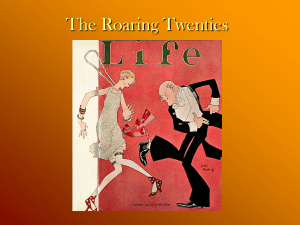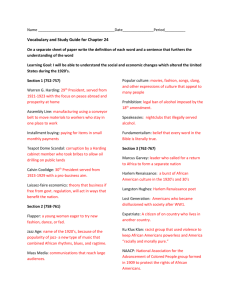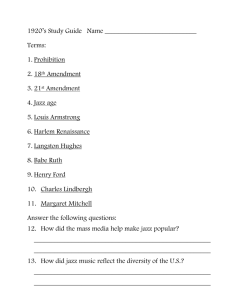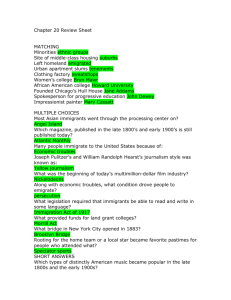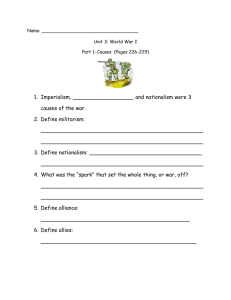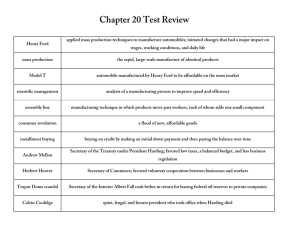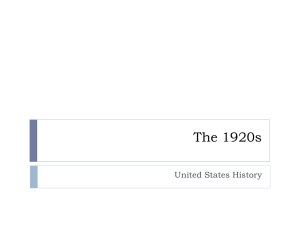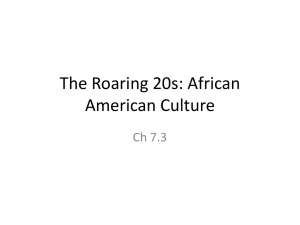The Reconstruction, Jazz and – 1929) Depression (1865 Meeting 5
advertisement
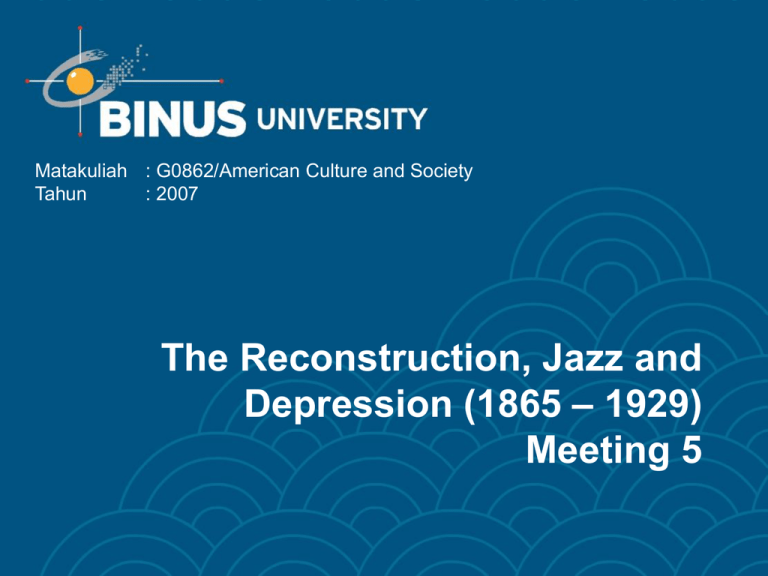
Matakuliah : G0862/American Culture and Society Tahun : 2007 The Reconstruction, Jazz and Depression (1865 – 1929) Meeting 5 Contents • • • • • • • • The reconstruction after the war The prosperity decade (1920 - 1928) The Ragtime era: Negroes on the spot World War I The Jazz Age and the Roaring Twenties Babe Ruth: baseball and Material culture The Dust Bowl The economic Crash: The great Depression 1929 The reconstruction The Emancipation Proclamation in 1863 freed African Americans in rebel states, and after the Civil War, the Thirteenth Amendment emancipated all U.S. slaves wherever they were. As a result, the mass of Southern blacks now faced the difficulty Northern blacks had confronted--that of a free people surrounded by many hostile whites. One freedman, Houston Hartsfield Holloway, wrote, "For we colored people did not know how to be free and the white people did not know how to have a free colored person about them." African American Population Distribution in 1890 African American population distribution and migration patterns can be traced using maps published in the statistical atlases prepared by the U. S. Census Bureau for each decennial census from 1870 to 1920. The atlas for the 1890 census includes this map showing the percentage of "colored" to the total population for each county. Although the heaviest concentrations are overwhelmingly in Maryland, Virginia, and the southeastern states, there appear to be emerging concentrations in the northern urban areas (New York City, Philadelphia, Pittsburgh, Cleveland, Toledo, and Chicago), southern Ohio, central Missouri, eastern Kansas, and scattered areas in the West (Oklahoma, New Mexico, Arizona, Nevada, and California), reflecting migration patterns that began during Reconstruction. Harlem Renaissance Harlem Renaissance, an African American cultural movement of the 1920s and early 1930s that was centered in the Harlem neighborhood of New York City. Variously known as the New Negro movement, the New Negro Renaissance, and the Negro Renaissance, the movement emerged toward the end of World War I in 1918, blossomed in the mid- to late 1920s, and then faded in the mid-1930s. The Harlem Renaissance marked the first time that mainstream publishers and critics took African American literature seriously and that African American literature and arts attracted significant attention from the nation at large. Although it was primarily a literary movement, it was closely related to developments in African American music, theater, art, and politics. The Ragtime Era The Ragtime era was a fast paced transformation where the pioneers of the American Dream tapped into successes of the selfmade man and the music of Scott Joplin woke the nation. E.L. Doctorow's novel Ragtime embraces the "New America" -- one that was filled with immigrants and those seeking to obtain the promised fortune in the land of dreams. Less fortunate people, mostly immigrants, had to deal with the pressures of racism and often tried to escape the barriers imposed on them by society. The issues of immigration and achieving the American Dream conflicted as the immigration rates rose and society became naturally selective about who could and could not achieve the idealized American Dream. The Brooklyn Bridge (1900) The Brooklyn Bridge (1932) The Jazz Age The Jazz Age Facts about the Jazz Age • • • • • • • • • • Prohibition and temperance Al Capone – Organized Crime Chicago Charles “Charlie” Chaplin “Silent Movie” Flappers : new culture (Fitzgerald’s The Great Gatsby) African American artists emerge to the public: Langston Hughes, Louis “Satchmo” Armstrong, etc. Jazz, blues becomes the most popular music in America. Sacco and Vanzetti trial The Monkey Scopes trial Freud and the psychology of the unconscious The most favorite sports: Base Ball Baseball Babe Ruth Babe Ruth and Baseball • George Herman Ruth, Jr. (February 6, 1895 – August 16, 1948), also known as "Babe", "The Great Bambino", "The Sultan of Swat", and "The Colossus of Clout", was an American Major League baseball player from 1914-1935. He is widely regarded as one of the greatest baseball players in history. Many polls place him as the number one player of all time. • He helped change baseball from a low-scoring, speed dominated game to a high scoring, power game. He became the first true American sports celebrity superstar whose fame transcended baseball. Off the field he was famous for his charity, but also was noted for his often reckless lifestyle that epitomized the hedonistic 1920s. Ruth became an American icon, and even though he died nearly 60 years ago his name is still one of the most famous names in all of American sports. Jackie Robinson The Dust Bowl Stock Market Crash 1929

